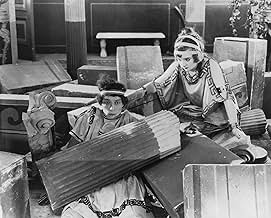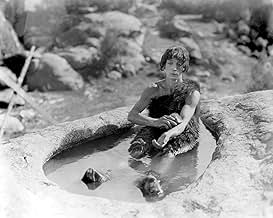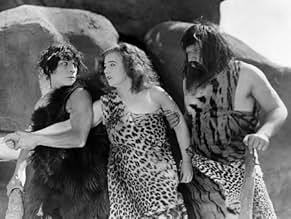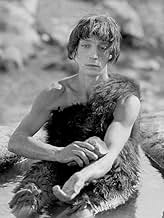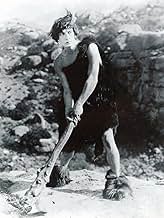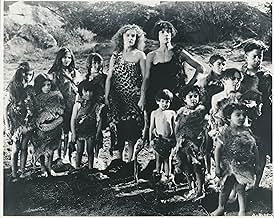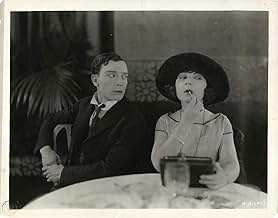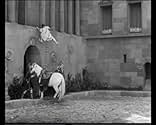AVALIAÇÃO DA IMDb
7,0/10
5,6 mil
SUA AVALIAÇÃO
Adicionar um enredo no seu idiomaThe misadventures of Buster in three separate historical periods.The misadventures of Buster in three separate historical periods.The misadventures of Buster in three separate historical periods.
- Direção
- Roteiristas
- Artistas
- Prêmios
- 1 indicação no total
Kewpie Morgan
- The Emperor
- (as Horace Morgan)
- …
Lionel Belmore
- Undetermined Role
- (não confirmado)
- (não creditado)
Bernard Berger
- Roman-age child
- (não creditado)
Basil Bookasta
- Stone Age Child
- (não creditado)
George Bookasta
- Stone Age Child
- (não creditado)
George Davis
- Roman Guard Knocked Down
- (não creditado)
Louise Emmons
- Old Fortune Teller
- (não creditado)
F.F. Guenste
- Butler
- (não creditado)
Blanche Payson
- The Amazon
- (não creditado)
Avaliações em destaque
First time of seeing Buster Keaton's first feature film and I have to admit I liked it a lot and only wish I'd stumbled across it years ago. The Rohauer blurb at the start warns that the Three Ages single nitrate print was rediscovered and salvaged in 1954 just in time before combustion, and many frames that seemed hopelessly glued together were separated. So, it's rocky viewing in places, but I've seen and survived much worse.
It would have been OK as the 3 short films but as a take on Intolerance it's inventive and funny from the start to the finish: In the Stone Age with baddie Wallace Beery riding an elephant and goodie Buster riding a pet brontosaurus; In the Roman Age Buster riding a chariot with wheel locks and adapted for sledging, No Parking signs in Latin; In this technological Age of Speed Need and Greed his car beautifully falls to bits at the first hump. Both him and Beery are after the Girl through the ages, a never ending tussle. Favourite bit: As the caveman he gets knocked backward over a cliff edge but still blows a kiss to the camera - an amazing second or two!
Great stuff, reaffirming my love of silent film comedy.
It would have been OK as the 3 short films but as a take on Intolerance it's inventive and funny from the start to the finish: In the Stone Age with baddie Wallace Beery riding an elephant and goodie Buster riding a pet brontosaurus; In the Roman Age Buster riding a chariot with wheel locks and adapted for sledging, No Parking signs in Latin; In this technological Age of Speed Need and Greed his car beautifully falls to bits at the first hump. Both him and Beery are after the Girl through the ages, a never ending tussle. Favourite bit: As the caveman he gets knocked backward over a cliff edge but still blows a kiss to the camera - an amazing second or two!
Great stuff, reaffirming my love of silent film comedy.
D.W. Griffith could have made any movie he wanted to after the enormous financial success of "The Birth of a Nation"; he chose to make the most technically ambitious film to that date, "Intolerance". He took a risk with such innovations in film montage and form, and the well-known financial train wreck resulted. Buster Keaton doesn't take that kind of a risk with "Three Ages", a parody of "Intolerance". This is Keaton's first feature-length film of his own (he only acted in "The Saphead"). He had the fallback plan of dividing the three episodes in this feature into three separate shorts, which Griffith did do with "Intolerance". Keaton didn't have to. Chaplin had already succeeded with feature-length comedies, so if Keaton was taking a risk here, it was completely calculated.
Chaplin had already done a parody of another film, too, with "Burlesque on Carmen" (1915). Keaton appears to allude to that parody, as well. The wrestling scene in the Ancient Rome episode references the swordfight that turns into a wrestling match in Chaplin's burlesque. The comical distance from the plot of both scenes is the same, too. Furthermore, Chaplin's film imitated the glossy style of DeMille's "Carmen", and Chaplin's film seemed a tribute to that film. Keaton doesn't attempt the radical editing, narrative structure or monumental nature in his parody, but it seems respectful of "Intolerance" nonetheless. At least, the stories aren't told completely straightforward as in other "Intolerance"-inspired works, such as Dreyer's "Leaves from Satan's Book" (Blade af Satans bog, 1921) and Fritz Lang's "Destiny" (Der Müde Tod, 1921). There is some mild jumping back and forth between episodes.
Where Keaton did take risks, however, is in his physical, daredevil comedy. That's Keaton unintentionally failing to jump across buildings in the modern episode. Reportedly, he was convinced to alter the scene rather than attempt the jump again. And, it wasn't just Keaton who took risks; the anachronistic baseball gag, for example, was rather dangerous. Thus, although in a different way, Keaton, like Griffith, took risks with his big film. And, I think they both succeeded.
Chaplin had already done a parody of another film, too, with "Burlesque on Carmen" (1915). Keaton appears to allude to that parody, as well. The wrestling scene in the Ancient Rome episode references the swordfight that turns into a wrestling match in Chaplin's burlesque. The comical distance from the plot of both scenes is the same, too. Furthermore, Chaplin's film imitated the glossy style of DeMille's "Carmen", and Chaplin's film seemed a tribute to that film. Keaton doesn't attempt the radical editing, narrative structure or monumental nature in his parody, but it seems respectful of "Intolerance" nonetheless. At least, the stories aren't told completely straightforward as in other "Intolerance"-inspired works, such as Dreyer's "Leaves from Satan's Book" (Blade af Satans bog, 1921) and Fritz Lang's "Destiny" (Der Müde Tod, 1921). There is some mild jumping back and forth between episodes.
Where Keaton did take risks, however, is in his physical, daredevil comedy. That's Keaton unintentionally failing to jump across buildings in the modern episode. Reportedly, he was convinced to alter the scene rather than attempt the jump again. And, it wasn't just Keaton who took risks; the anachronistic baseball gag, for example, was rather dangerous. Thus, although in a different way, Keaton, like Griffith, took risks with his big film. And, I think they both succeeded.
This is a pleasant and funny combination of slapstick and satire, period humor and romantic comedy. It does not have quite the number of sustained chase/stunt sequences as in most of Keaton's features, but instead there are a lot of fine subtle gags of all different kinds.
In each of the "Three Ages", Buster and Wallace Beery vie for the affections of the same woman, with amusing and unpredictable results. The simple romantic triangle theme sets up a lot of good material, on the one hand lending itself to a lot of gags about the unchanging nature of romantic courtship, and on the other hand being used for a lot of deliberate anachronisms that are often extremely funny. Beery makes a nice foil for Keaton, and the girl's parents also have some good moments.
This one usually gets lost in the crowd among so many brilliant Keaton masterpieces, but it works very well and is definitely worth seeing for any fan of silent comedy.
In each of the "Three Ages", Buster and Wallace Beery vie for the affections of the same woman, with amusing and unpredictable results. The simple romantic triangle theme sets up a lot of good material, on the one hand lending itself to a lot of gags about the unchanging nature of romantic courtship, and on the other hand being used for a lot of deliberate anachronisms that are often extremely funny. Beery makes a nice foil for Keaton, and the girl's parents also have some good moments.
This one usually gets lost in the crowd among so many brilliant Keaton masterpieces, but it works very well and is definitely worth seeing for any fan of silent comedy.
Although the movie is clearly dated, audiences can still easily identify with the plight of hapless Buster in this timeless and very funny underdog tale. Buster fights against unkindly odds in three different ages: the Stone Age, The Roman Age, and the Moden Age, playing almost the same character with just a change of scenery to help us identify the different "ages". In this movie we see one of the earliest comedic depictions of the "caveman" stereotype, who wins his love not by romance but by brute force, as well as a funny twist on Roman gladiatorial combat, two comedic sketches that long predate such spoofs as Mel Brooks' "History of the World: Part I". The underlying theme of the movie is simple yet convincing: Although the times may have-a-changed, we still face the same struggles even in modern times that we fought in prehistoric times in order to "win the girl" (keep in mind this is the theme of 1923 America, a time when chauvinism was still en vogue). It is interesting to look at this movie over eighty years later, and consider how dramatically things have changed from this movie's "modern times" to now.
Buster presents love stories from three periods in history - the Stone Age, the Roman Age, and the Modern Age. In each, he vies for the affection of a young woman with another man, thus illustrating that emotions like love and jealousy have been constant for time immemorial, a contrast to what D. W. Griffith was trying to highlight in Intolerance, which Buster was parodying.
While the three stories are interleaved together, it's notable that at a 63 minute runtime, this is essentially three two-reel shorts put together. As Keaton put it, "Cut the film apart and then splice up the three periods, each one separately, and you will have three complete two-reel films."
The Stone Age story has lots of gags that The Flintstones would later borrow, such as prehistoric golfing, taking dictation by chiseling into a stone, and presenting a business card comprised of a small slab of rock with a crude likeness drawn on it. Buster standing atop a dinosaur, despite the bad science and primitive stop-motion effects, made me smile. The best moment, however, was when he tries to arouse jealousy in his beloved by attempting to grab another woman by the hair and take charge of her, only to find she's at least a foot taller than him. She knocks him off the rock and we get that marvelous shot of him look up into the camera on the way down to a pond below, kissing his fingers before spreading his arms wide.
The Roman Age story has a lot of the same types of visual gags, like a wristwatch made with a sundial, Buster playing an impromptu game of craps with dice with Roman numerals on the sides, and him pulling his chariot up to a "No parking" sign in Latin (naturally, mistranslating Non Postum Exit). The best gag was when he engages in a chariot race in the hippodrome using one pulled by dogs. When one starts slowing down, he replaces it like a spare tire with another that's stashed in his trunk, which was hilarious.
The Modern Age of "speed, need, and greed" features some amusing moments on the gridiron, like Buster being propped up by an opponent so he can be knocked down each play, and handing the ball off when he's about to be creamed on a punt return. There's also a clever getaway shot from above where he goes through one taxi to another faced in the opposite direction, and when the two cabs drive off, his pursuers think he's in the first. Nothing tops that extraordinary leap from one building to another, however, where Buster missed the jump in real life. While there was a safety net 35 feet below him, he hit it hard and awkwardly enough that he injured his knees, hips, and elbows, and had to stay in bed for several days afterwards. How he then improvised the awnings and slid into the fire department was brilliant, and "the biggest laughing sequence in the picture...because I missed it in the original trick," as he put it.
Overall the film wasn't helped by being so drawn out as the pace of the jokes probably could have been faster, but there's a lot to like here. Pretty cute ending too.
While the three stories are interleaved together, it's notable that at a 63 minute runtime, this is essentially three two-reel shorts put together. As Keaton put it, "Cut the film apart and then splice up the three periods, each one separately, and you will have three complete two-reel films."
The Stone Age story has lots of gags that The Flintstones would later borrow, such as prehistoric golfing, taking dictation by chiseling into a stone, and presenting a business card comprised of a small slab of rock with a crude likeness drawn on it. Buster standing atop a dinosaur, despite the bad science and primitive stop-motion effects, made me smile. The best moment, however, was when he tries to arouse jealousy in his beloved by attempting to grab another woman by the hair and take charge of her, only to find she's at least a foot taller than him. She knocks him off the rock and we get that marvelous shot of him look up into the camera on the way down to a pond below, kissing his fingers before spreading his arms wide.
The Roman Age story has a lot of the same types of visual gags, like a wristwatch made with a sundial, Buster playing an impromptu game of craps with dice with Roman numerals on the sides, and him pulling his chariot up to a "No parking" sign in Latin (naturally, mistranslating Non Postum Exit). The best gag was when he engages in a chariot race in the hippodrome using one pulled by dogs. When one starts slowing down, he replaces it like a spare tire with another that's stashed in his trunk, which was hilarious.
The Modern Age of "speed, need, and greed" features some amusing moments on the gridiron, like Buster being propped up by an opponent so he can be knocked down each play, and handing the ball off when he's about to be creamed on a punt return. There's also a clever getaway shot from above where he goes through one taxi to another faced in the opposite direction, and when the two cabs drive off, his pursuers think he's in the first. Nothing tops that extraordinary leap from one building to another, however, where Buster missed the jump in real life. While there was a safety net 35 feet below him, he hit it hard and awkwardly enough that he injured his knees, hips, and elbows, and had to stay in bed for several days afterwards. How he then improvised the awnings and slid into the fire department was brilliant, and "the biggest laughing sequence in the picture...because I missed it in the original trick," as he put it.
Overall the film wasn't helped by being so drawn out as the pace of the jokes probably could have been faster, but there's a lot to like here. Pretty cute ending too.
Você sabia?
- CuriosidadesThe most famous stunt in the movie was actually built around what went wrong with the original stunt. Buster Keaton intended to leap from a board projecting from one building onto the roof of another building, but he fell short, smashing into the brick wall and falling into a net off-screen. He was injured badly enough to be laid up for three days. However, when he saw the film (the camera operators were instructed to always keep filming, no matter what happened), he not only kept the mishap, he built on it, adding the fall through three awnings, the loose downspout that propels him into the firehouse and the slide down the fire pole.
- Erros de gravaçãoIn the medium shot of the Stone Age soothsayer scene, Buster's hands are resting together near the side of the turtle. But in the cut to a close-up, we see only a hand double's right hand, and it's directly in front of the turtle's mouth. (It's clearly a hand double, since Keaton was missing his right index finger tip.)
- Versões alternativasIn 1995, Film Preservation Associates copyrighted a version with an orchestral score; no details were specified on the print.
- ConexõesEdited into The Golden Age of Buster Keaton (1979)
Principais escolhas
Faça login para avaliar e ver a lista de recomendações personalizadas
- How long is Three Ages?Fornecido pela Alexa
Detalhes
- Data de lançamento
- País de origem
- Idioma
- Também conhecido como
- A Idade da Pedra
- Locações de filme
- Empresa de produção
- Consulte mais créditos da empresa na IMDbPro
Bilheteria
- Faturamento bruto mundial
- US$ 177
- Tempo de duração
- 1 h 3 min(63 min)
- Cor
- Mixagem de som
- Proporção
- 1.33 : 1
Contribua para esta página
Sugerir uma alteração ou adicionar conteúdo ausente

